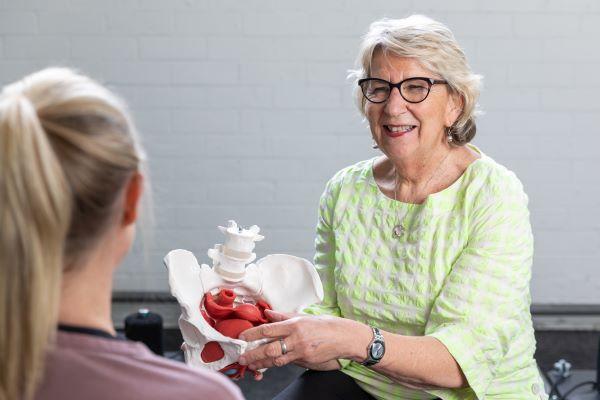, Bridge Magazine , News
In this women’s health edition, we want to create a safe space for women to understand their own body and seek help should they need it. We talk to Libby Oldfield, a Specialist Women’s, Men’s and Pelvic Health Physiotherapist for some top tips on how to keep your pelvic floor healthy and risk factors to watch out for which are relevant to women of all ages and stages of life.
What is my pelvic floor and why is it important?
The muscles of the pelvic floor form a bowl shape that sits at the base of your pelvic bones and helps support your internal pelvic organs (bladder, bowels, and uterus). When it is healthy you can exercise, go to the toilet and have sex with no issues. If you have a problem with your pelvic floor, you may experience problems with these things.
Your pelvic floor is also important for your posture, it helps supports your entire trunk and makes up part of your core group of muscles which support your body as you move.
There are many stages of life that can present a risk to your pelvic floor. This includes activities such as regular high intensity exercise and heavy lifting, menopause, and pregnancy and birth, which can add strain to your pelvic floor muscles. Just like with continence problems, pelvic floor problems can also be treated by a Pelvic Health Physiotherapist.

Problems with your pelvic floor
When you think about incontinence, you may think it only affects the elderly or new mums. But issues around leaking urine when you cough, sneeze or exercise, waking up multiple times during the night to go to the toilet, or having the urge to go to the toilet very frequently, can all be symptoms of bladder and bowel problems that affect women of all ages.
Your muscles are coordinated by your brain. Incontinence and pelvic floor muscle dysfunction might not be directly related to a physical issue with your bladder, there could be many other factors at play.
One factor that can impact your continence is stress. The pelvic floor is very vulnerable to stress and reacts to your brain’s fight or flight response. Stress can make your body tighten the pelvic floor muscles and not relax them, leaving the muscles tired and without energy to contract and hold your urine while you cough or sneeze, causing leakage or have difficulty using tampons or pain free sex.
Overactive bladder (strong urges and perhaps leaking when you get the urge) is another example of a bladder and/or pelvic floor problem that can be affected by stress. Pelvic Health Physios can help you work on your brain-bladder connection, your pelvic floor muscles and help with good bladder and bowel habits to ensure that life’s stresses don’t have a negative effect on your toilet habits.
“I love my job because of the difference I make in helping people understand that what they are experiencing is not normal. And they don’t have to live with it. With the correct advice and management, there are often simple things they can do to change it.” Libby
Constipation (not being able to poo easily) is another condition that can cause your pelvic floor some issues. If you strain on the toilet or spend too long there, it can weaken your pelvic floor and cause you to leak urine during daily activities. Alternatively, if your constipation is caused by pelvic floor dysfunction, you might find it hard to let the poo or wee out when you want to, leading to more frequent trips to use the toilet.
Signs you might be experiencing issues with your pelvic floor
- Strong urges to wee and frequent toilet visits that impact your life
- Leaking wee or poo during exercise, or when you cough or sneeze
- Leaking wee when you get a strong urge to go to the toilet
- Waking multiple times during the night to visit the toilet
- Difficulty with going to the toilet
- Painful sex or difficulty with tampons
When do I need to speak to someone?
It is never too late to get help with these issues. Even if your symptoms started years or decades ago.
If you answer yes to one of these questions, get help, even if you have had the symptoms for years, treatment can relieve the symptoms
Acknowledging you have a problem is the first step. The second step is realising you don’t have to live with it. It is not a natural consequence of ageing, childbirth or being a woman, and there are things you can do to treat all issues around toileting.
“I love helping women achieve their goals. The first question I ask them is: what is it that you can't do at the moment that you would like to do?” Libby
The best place to start is a Pelvic Floor Physiotherapist, a postgraduate trained Physio who will understand the complexities of your problems.
At your initial appointment the Pelvic Health Physiotherapist will start by asking questions about your general life and details of your condition. Don’t be embarrassed to tell them what has been happening to your body, these professionals talk wee and poo all day and know how to ask questions in a respectful way. They will not be surprised by anything you tell them. They will listen non-judgmentally and offer a mix of exercises, product suggestions, lifestyle adjustments, and can help you start a bladder/bowel diary to really get to know your body.
Not ready to talk to someone in person? Visit continence.com.au for more information or call our National Continence Helpline for confidential advice 1800 33 00 66 (Mon-Fri 8am-8pm AEST).

